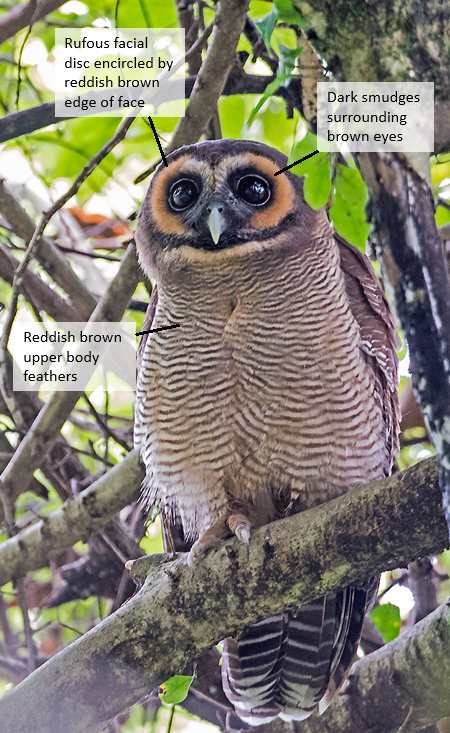Strix seloputo (Horsfield, 1821)
Table of Contents
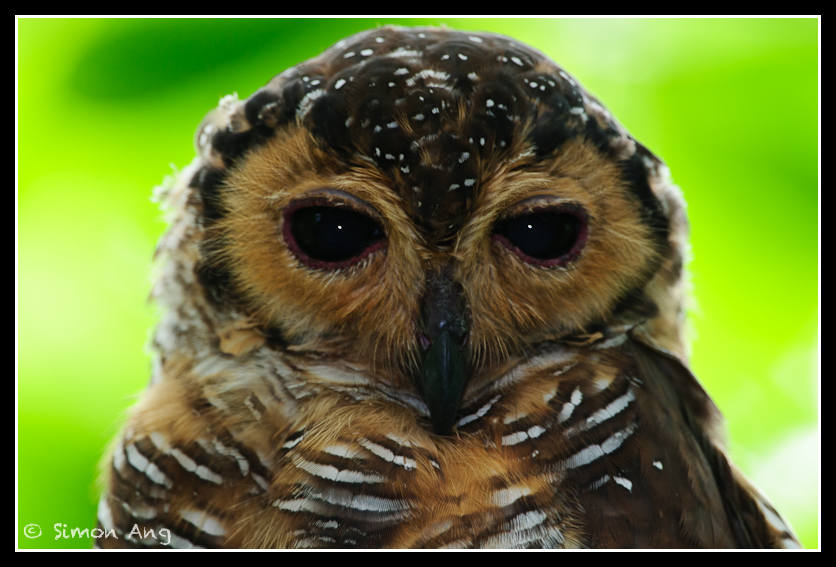 |
| Photograph by: Simon Ang (2010) under creative commons (CC) |
1. Introduction
Being the largest owl in Singapore[1-1], the spotted wood owl is a medium sized owl that can be found in a number of areas in South East Asia. While these owls used to be rare in Singapore, their numbers seemed to have risen and are sighted more often now. It is one of the only two owls from the Strix genus in Singapore, the other being the brown wood owl (Strix leptogrammica).
Back to top
2. Etymology/Mythology
The name “Strix” means “owl” in Greek. In Ancient Roman and Greek legends, striges (plural of strix) were winged beasts, possessing four legs with clawed feet. They feed on human flesh and blood and are said to be the “harbinger of war and civil strife to men”[2].
Currently, the name “Strix” refers to earless owls, although these owls are not the only ones without ear-tuffs. It also refers to wood owls, which is a generic name for forest-living owls.
Back to top
3. Description
(i) General
The pictures below show the easily identifiable traits of the spotted wood owl.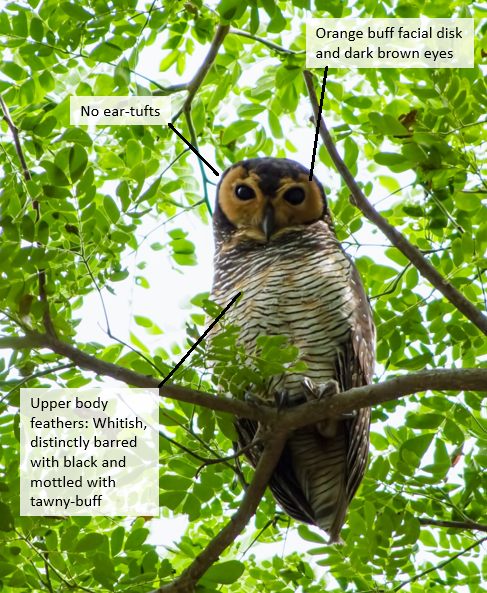 |
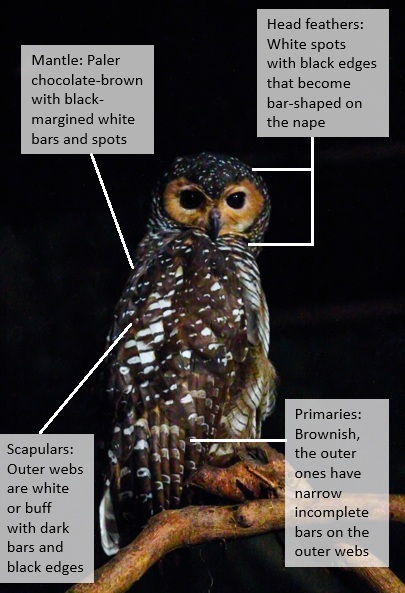 |
| Adapted from photograph by: looyaa (2013) under CC |
Adapted from photograph by: _paVan_ (2013) under CC |
(ii) Detailed
If unfamiliar with the anatomy of owls, please refer here first for a clearer understanding of the following descriptions. The descriptions below are summarized from Owls of the world[3] with additional information from The Owl Pages[4-1].| Face |
Facial disc |
Orange-buff facial disk with a dark rim |
| Eyes |
Dark brown eyes |
|
| Ear-tufts |
No ear-tufts |
|
| Bill |
Greyish/Greenish-black bill |
|
| Cere |
Greenish-black cere |
|
| Feathered body parts |
Head |
Chocolate-brown with golden bases and white spots with black edges that become bar-shaped on the nape |
| Chin |
Buff |
|
| Throat |
White |
|
| Upper body |
Chocolate-brown, profusely marked with black-edged white spots |
|
| Back, mantle, upper tail coverts |
Paler chocolate-brown with black-margined white bars and spots |
|
| Tail |
Dark brown, with 5-6 visible yellowish-white bars, bordered black |
|
| Underparts |
Whitish, distinctly barred with black and mottled with tawny-buff |
|
| Scapulars |
Outer webs are white or buff with dark bars and black edges |
|
| Primaries |
Brownish, the outer ones have narrow incomplete bars on the outer webs |
|
| Thighs and tarsi |
White, washed with buff and barred with black |
|
| Toes |
Dark olive with horn-coloured claws |
(iii) Subspecies
The subspecies of the spotted wood owl are found in different localities and have minor morphological differences[5-1].S. seloputo seloputo is found in southern Myanmar and Central Thailand to Singapore and discontinuously to Central Sumatra and Java.
S. seloputo baweana is found on Bawean Island, off Northern Java. This subspecies is smaller and paler, with narrower barring on underparts. (Photograph unfortunately unavailable)
S. seloputo wiepkeni is found on Calamian and Palawan Islands, in Western Philippines. This subspecies has yellowish-rufous ground-coloured feathers on the underparts. (Photograph below.)
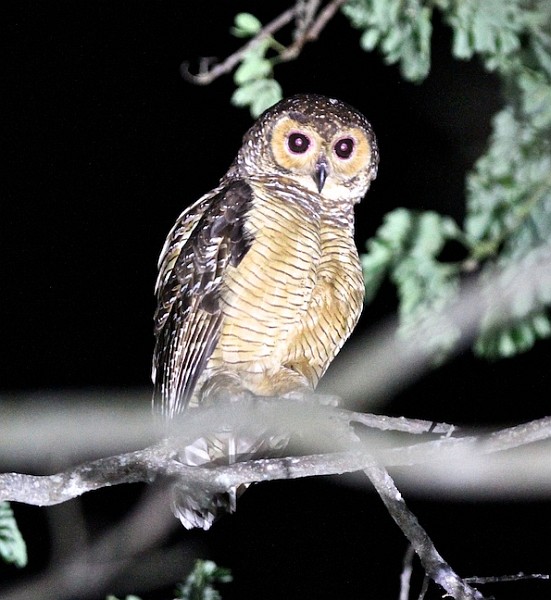 |
| Adult S. seloputo wiekeni photographed in Palawan, Philippines. Photograph by: Lim Kim Chuah(2013) Copyright permission granted. |
(iv) Juveniles
Juveniles have a white down finely barred dark brown[5-2]. Otherwise, they are just smaller in size as compared to adults.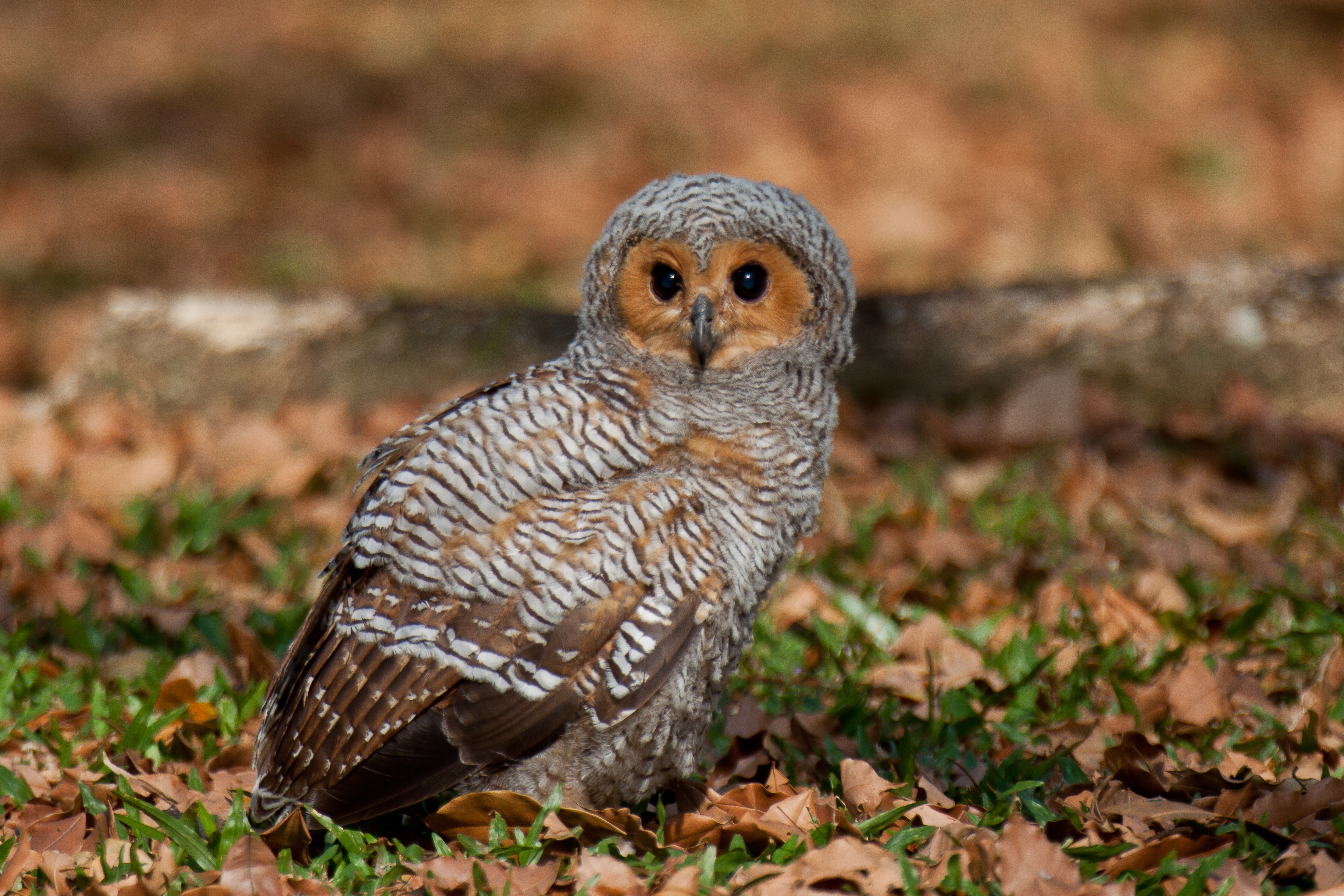 |
| Photograph by: Darren Bellerby (2015) under CC |
Video by: Leong Tzi Ming (2015) under CC |
(v) Measurements
The following measurments are taken from a number of different specimens, with the exception of the body mass, which was obtained from a single male[6].
| Length |
44-88 cm |
| Wing length |
297-376 mm |
| Tail length |
175-198 mm |
| Tarsus |
58-60 mm |
| Bill length |
39-45 mm |
| Body mass |
1011 g (n = 1 male) |
Back to top
4. Diagnosis
Of the 6 different species of owls from the Strix genus that can be found in Asia, the 3 below are harder to tell apart.
(i) General
| Brown Wood Owl (Strix leptogrammica) |
Spotted Wood Owl (Strix seloputo) |
Mottled Wood Owl (Strix ocellata) |
|
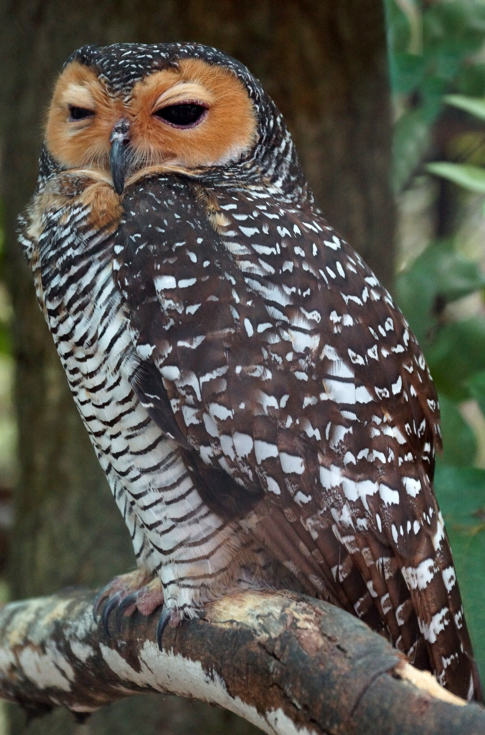 |
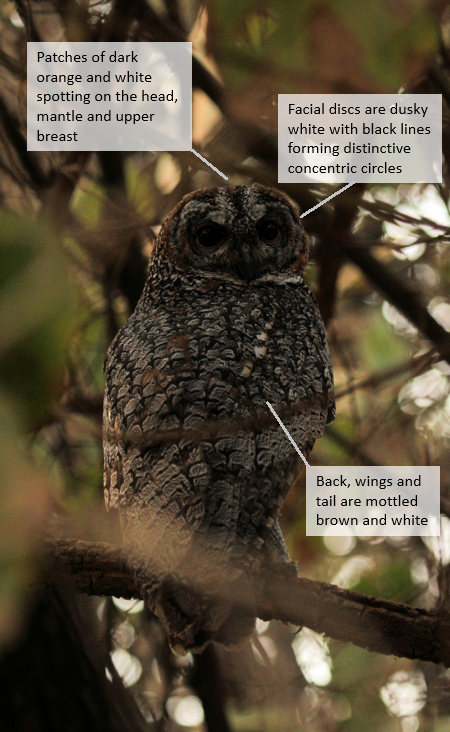 |
||
| Adapted photograph by: Koshy Koshy (2014) under CC |
Adapted photograph by: Aaron Fellmeth (2013) under CC |
Adapted photograph by: Michael Bramford (2013) under CC |
|
Back to top
(ii) Detailed
The table below is a summary of some of the features that are easily distinguished visually[4-3].| Brown wood owl |
Spotted wood owl |
Mottled wood owl |
|
| Facial disc |
Rufous in colour, encircled by reddish brown |
Orange-buff with a dark rim |
Dusky white |
| Facial patterns |
Dark smudges around eyes |
- |
Black lines forming concentric circles around the eyes |
| Bill |
Pale greenish-horn with blue base |
Greenish-black |
Horn-black with a paler tip |
| Underside feathers |
Creamy-buff and densely barred brown. |
Whitish, distinctly barred with black and mottled with tawny-buff |
White with golden-buff to orange-buff and with narrow blackish bars |
| Mantle |
Chestnut-brown and rather densely barred dark brown to blackish |
Paler chocolate-brown with black-margined white bars and spots |
Mottled and vermiculated with reddish-brown, black, white and buff, with prominent black spotting on the nuchal area |
| Toes |
Pale leaden with dull grey claws |
Dark olive with horn-coloured claws |
Dirty yellowish-brown with horn-black claws. |
Back to top
5. Calls
Spotted wood owl calls are generally low-pitched and ends with a prolonged, deep “hooo”[7-1]. Loud, quivering, eerie “chuhua-aa” calls are uttered regularly upon emerging from daytime roost, returning at dawn and infrequently during the night[5-3](XC239428).On other occasions, the owl gives a rising mellow, “hoo”, at intervals of about 5 seconds[8-1](XC240370 and the videos below).
| Listen to more calls at the xeno-canto website. |
|
Dusk duet by spotted wood owls. Video by: Leong Tzi Ming (2014) under CC Spotted wood owls hooting. Video by: Leong Tzi Ming (2013) under CC |
|
6. Range
(i) Global
The spotted wood owl is resident to Southern Burma, Thailand, Cambodia, South Vietnam, Malay Peninsula, Singapore, Central Sumatra, discountinuously to Java, Bawean Island off Northern Java, Calamian Islands and Palawan, Western Philippines[9-1]. |
| Yellow highlighted areas indicate the world distribution of the spotted wood owl. The red circle indicates where the subspecies S. seloputo wiepkeni is found and the red arrow indicates where the subspecies S. seloputo baweana is found. Adapted image from: IUCN[9-2] |
Back to top
(ii) Locally (Singapore)
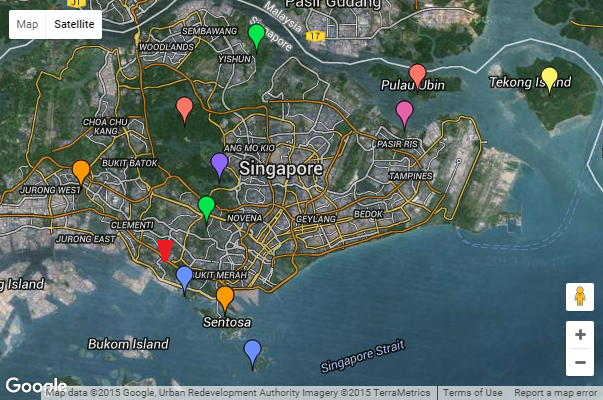 |
| Map of Singapore with locations of sightings of the owls marked. Adapted image from: Lee Kong Chian Natural History Museum |
In addition to the sightings as indicated on the map, an additional location, National University of Singapore, is marked with a red arrowhead. There have been sightings of a breeding pair in the university compound, with a single chick that was born in 2015.
For information about the spotted wood owl's distribution in Singapore, refer here.
Back to top
7. Biology
(i) Habitat
The spotted wood owls are found to inhabit plantations, partially cleared forests, evergreen secondary forests, forest edges, and parks near urbanized areas. They forage freely in open and semi-open country, orchards and parks. They are also sometimes found to inhabit unpopulated and remote regions such as swamp forest and mangroves near the coast[4-4]. Locally, they are found in protected forest areas (Central catchment nature reserve), larger parks (Chinese Garden and Pasir Ris Park) and off-shore islands (Sentosa and St. John's).Back to top
(ii) Behaviour
The spotted wood owl is a nocturnal bird, becoming active at dusk, it can be very vocal at this time, and also when returning at dawn[4-5]. These owls roost by day, often in pairs, close to the trunk in densely foliaged tall trees or groves of trees[4-5]. They also frequent the middle story or tall trees in suburban woodlands[8-2].Despite their nocturnal habits, they have to sun themselves once in a while. This behaviour belongs to a category of actions known as "comfort actions", which also includes preening and stretching[7-2]. An instance of this sunning behaviour was captured in Pasir Ris Park, read more about it here.
In order to cope with the tropical climate, many birds including spotted wood owls pant to cool themselves, this is known as gular fluttering[15]. An example of such behaviour can be seen in the following video.
| Gular fluttering of spotted wood owl. Video by: green3birdie (2013) under CC |
(iii) Feeding/Hunting
The spotted wood owl feeds mainly on small rodents, small birds and large insects, however, there are exceptions whereby take snakes and bats were preyed upon[5-4]. Like other forest species of owls, the spotted wood owl typically hunts from perch at 2-3 metres above the ground, using the “sit-and-wait” strategy[5-4]. Once the prey is detected, it drops or glides from the perch and attacks the prey on the ground. The prey is killed with the talons and a bite to the back of the skull[5-4]. An example of the "sit-and-wait" strategy can be viewed from the video below.| "Sit-and-wait" strategy. Video by: Jeffrey Simonson (2012) under CC |
(iv) Asymmetric ears
For owls to be able to pin-point their target's location in darkness or beneath snow (as in the video above), they rely on their superior sense of hearing (vertical directional hearing)[16-1]. This is because they have bilaterally asymmetric ears (whereby one ear is higher or of different size/shape than the other), which allows for the vertical localization of sound via binaural comparison of signals[16-1].In a study done by Norberg (1977) , the different types of ear asymmetry can be broadly classified as asymmetry confined to soft-anatomy structures and asymmetry of skull. The spotted wood owl falls under the former group, with only the right ear aperture being larger than the left ear's[16-1].
An example of an asymmetric skull of belonging to a boreal owl (Aegolius funereus) is shown below.
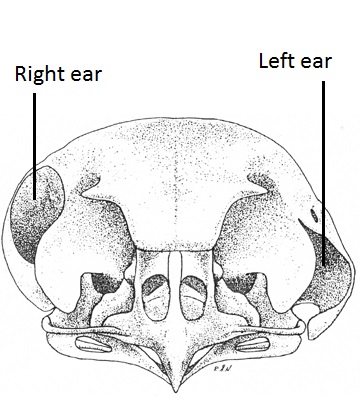 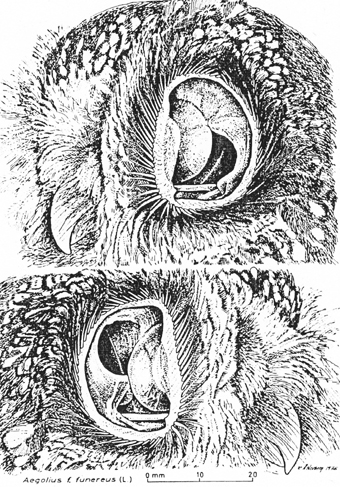 |
| Asymmetry of Aegolius funereus outer ears due to asymmetry of skull (figure on the left). Left outer ear (upper) and right outer ear (lower) are shown in the figure on the right. Adapated figures from: Norberg (2002)[17] |
More on the asymmetry of ears will be discussed below, in the phylogeny section.
Back to top
(v) Breeding
The breeding season takes place from January to August. Young fledglings can be seen from March till October. Even though nests have been recorded[7-3], they usually breed in tree holes or on open branches, sometimes on the top of a Bird's nest fern, often high up in a tall tree. Usually 2, but sometimes 3 eggs are laid. They are oval, pure white and average about 49 x 42 mm[4-6].Back to top
8. Conservation status
According to the IUCN red list, the spotted wood owl is considered to be of “Least Concern”[9-3]. However, locally, their population size was last estimated to be 22 or more and the owl is listed as critically endangered[10]. Even though their population is thought to be increasing recently[1-2], it is still under threat from human activities such as deforestation and forest degradation.
Back to top
9. Taxonomy and systematics
(i) Taxonomic rank
Kingdom: AnimaliaPhylum: Chordata
Class: Aves
Order: Strigiformes
Family: Strigidae
Genus: Strix
Species: Strix seloputo
In light of the fact that taxonomic ranking of organisms are still widely used today, it is included for reference.
Back to top
(ii) Original Description
The spotted wood owl was initially described by Thomas Horsfield (in Latin) in 1821.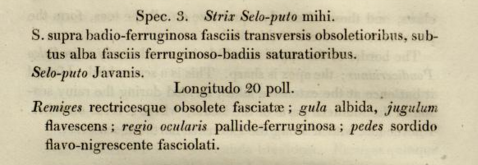 |
| Original description of the spotted wood owl. Adapted from: Transactions of the Linnean Society of London[11] |
Direct translation*:
"Upper body rust-coloured and covered with incomplete bands, underside white and saturated with reddish-brown bands.
Selo-puto of Java.
Length 20 poll++
Flight feathers incompletely banded; throat white, turning yellow at the neck; eye-region pale reddish-brown; feet dirty with yellow-black bands."
* Translation was performed with the help of Wikitionary and no prior knowledge of Latin, as such the translated text may be inaccurate.
++ Possibly a unit of measurement used in the past.
Back to top
(iii) Holotype
An adult specimen of the spotted wood owl can be found at the Natural History Museum (London)[12].Back to top
(iv) Phylogeny of Strix
Tribe Strigini is a broader taxonomic group which includes the genera Strix, Jubula, Lophostrix and Pulsatrix[13-1]. As of now, there are 21 recognised species of Strix owls[14].Evolutionary relationships of owls can be inferred by the morphological structures that they share or differ in. One such example is the asymmetry in their ears, which is hypothesised to have at least 5 cases of independent origin and gave rise to two major forms; asymmetry in soft-anatomy structures or asymmetry of the skull[16-2].
Based on the morphological data, Norberg (1977) came up with the following figure in an attempt to trace the evolutionary history of owls.
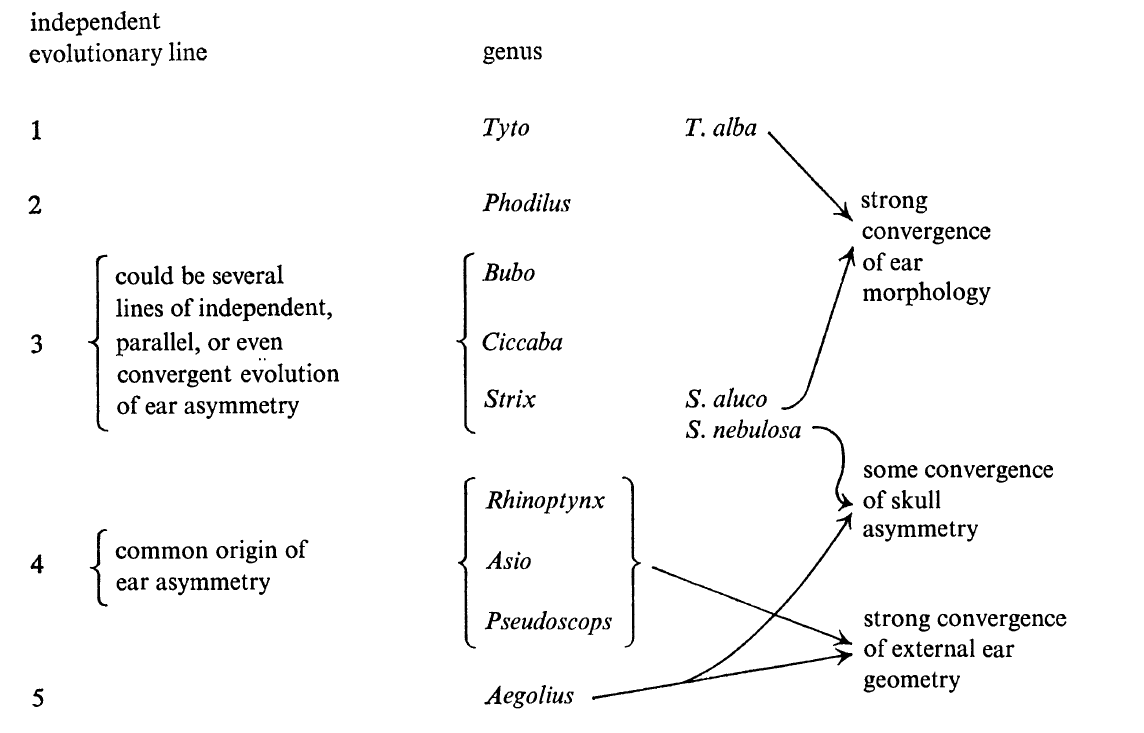 |
| Evolutionary line of owls based on ear asymmetry. Adapted figure from: Noberg (1997)[16-3] |
This evidence came in the form of a study by Wink et al (2009), which used molecular data from the DNA sequences of mitochondrial cytochrome b and nuclear RAG-1 gene of owls to map out a phylogenetic tree. The data suggests that the tribe Bubonini, which includes the buffy fish owl (Bubo ketupu), is of a different tribe but also a sister group to the tribe Strigini[13-2]. However, the data also suggests that the Pulsatrix may not be part of the tribe Strigini, thus, a new group, Pulsatrigini, is proposed[13-2].
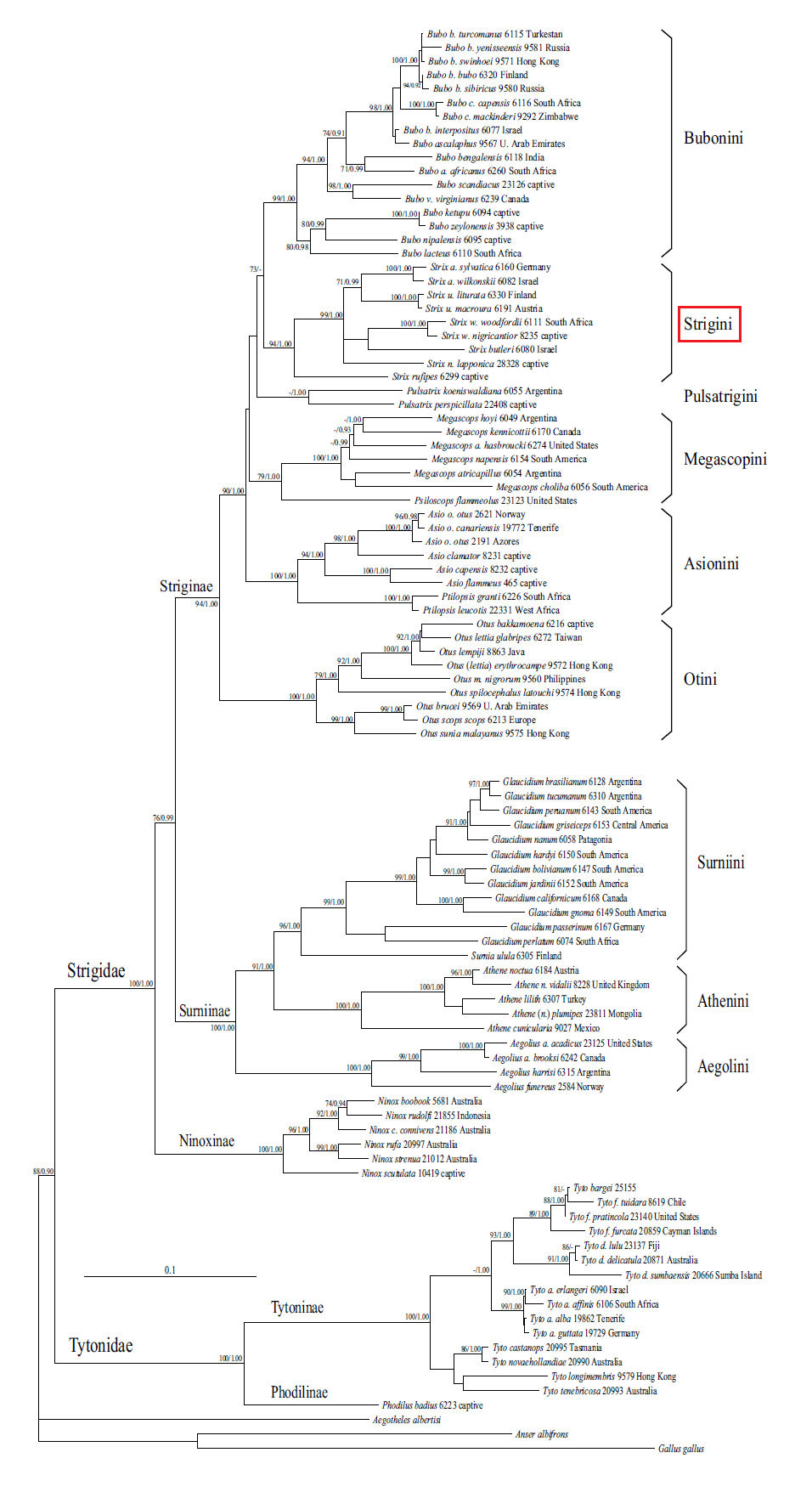 |
| Phylogenetic tree of owls, based on cytb and RAG-1 sequences. The numbers at the nodes indicate the ML bootstrap values/BI posterior probability values. Adapted image from: Wink et al. (2009)[13-3] |
10. References
[1-1], [1-2]. Tan, K. H. Owls. Retrieved from http://singaporebirds.blogspot.sg/2012/06/owls.html (Accessed on 10 Nov 2015).
[2]. Oliphant, S. G. 1913. The Story of the Strix: Ancient. Transactions and Proceedings of the American Philological Association - The Johns Hopkins University Press. 44: 133–49.
[3]. König, C. & F. Weick, 2010. Owls of the world. Christopher Helm Publishing, London. 354-355 pp.
[4-1], [4-2], [4-3], [4-4], [4-5], [4-6]. Lewis, D. Spotted Wood Owl - Strix seloputo - Information, Pictures, Sounds. Retrieved from http://www.owlpages.com/owls.php?genus=Strix&species=seloputo (Accessed on 10 Nov 15)
[5-1], [5-2], [5-3], [5-4]. Bouglouan, N. Spotted Wood-owl Strix seloputo Retrieved from http://www.oiseaux-birds.com/card-spotted-wood-owl.html (Accessed on 10 Nov 15)
[6]. Weick, F. 2006. Owls (strigiformes): Annotated and illustrated checklist. Springer-Verlag, Berlin. 127 pp.
[7-1], [7-2], [7-3]. del Hoyo, J., A. Elliott & J. Sargatal, 1999. Handbook of the birds of the world. Vol. 5. Barn-owls to hummingbirds. Lynx Edicions, Barcelona. 76-242 pp.
[8-1], [8-2]. Jeyarajasingam, A. & A. Pearson, 2012. A Field Guide to the Birds of Peninsular Malaysia and Singapore. Oxford University Press, Oxford. 232-233 pp.
[9-1], [9-2], [9-3]. BirdLife International, 2012. Strix seloputo. The IUCN Red List of Threatened Species 2012: e.T22689061A40387202. http://dx.doi.org/10.2305/IUCN.UK.2012-1.RLTS.T22689061A40387202.en . Accessed on 20 November 2015
[10]. Davison, G. W. H., Ng, P. K. L., Ho, H. C., & Nature Society (Singapore). (2008). The Singapore red data book: Threatened plants & animals of Singapore (2nd ed.). Singapore: Nature Society. 181 pp.
[11]. Transactions of the Linnean Society of London. 1821. Linnean Society of London, 13: 140. Retrieved from http://biodiversitylibrary.org/page/754873 (Accessed on 22 Nov 2015)
[12]. GBIF Secretariat: GBIF Backbone Taxonomy, 2013-07-01. URL: http://www.gbif.org/species/2497492 (accessed on 11 Nov 2015)
[13-1], [13-2], [13-3] Wink, M., A. El-Sayed, H. Sauer-Gürth & J. Gonzalez, 2009. Molecular phylogeny of owls (Strigiformes) inferred from DNA sequences of the mitochondrial cytochrome b and the nuclear RAG-1 gene. ARDEA, 97 (4) : 581 - 591
[14]. König, C., Weick, F., & Becking, J.-H, 1999. Owls: A Guide to the Owls of the World. New Haven and London: Yale University Press. 323-347 pp.
[15]. Bartholomew, G.A., Lasiewski, R.C., Crawford, E. C. & Crawford Jr., 1968. Patterns of Panting and Gular Flutter in Cormorants, Pelicans, Owls, and Doves. The Condor, 70(1) : 31-34
[16-1], [16-2], [16-3], [16-4]. Noberg, R. A., 1997 Occurrence and Independent Evolution of Bilateral Ear Asymmetry in Owls and Implications on Owl Taxonomy. Philosophical Transactions B, 280 (973) : 357-408
[17]. Noberg, R. A., 2002 Independent evolution of outer ear asymmetry among five owl lineages; morphology, function and selection. In: Newton, I., Kavanagh, R., Olsen, J. and Taylor, I. 2002. Ecology and Conservation of Owls. Australia: CSIRO Publishing. 329-342 pp.
Back to top
